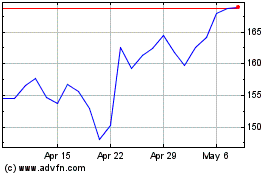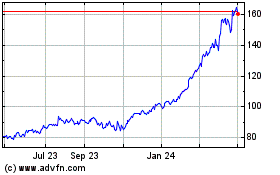GE to Turn Focus to Finance Unit After Fixing Power Business -- WSJ
May 23 2019 - 3:02AM
Dow Jones News
By Thomas Gryta
This article is being republished as part of our daily
reproduction of WSJ.com articles that also appeared in the U.S.
print edition of The Wall Street Journal (May 23, 2019).
Larry Culp, General Electric Co.'s chief executive, plans to set
his sights on the company's problematic financial-services business
after he cuts overall debt and stabilizes its power-generation
division, he told investors Wednesday.
In a wide-ranging presentation at the Electrical Products Group
conference, Mr. Culp reiterated GE's latest financial forecasts and
discussed the steps he is taking to streamline its operations. "We
are changing the way we run the business," he said. "From a
business that was often run top-down...to a business that's going
to be run from the bottom up."
GE has struggled the past two years -- losing $200 billion in
market value over 2017 and 2018 -- with slumping profits in its
power business and troubles in GE Capital, leading it to change
CEOs, cut its dividend twice and set plans to break itself apart.
Mr. Culp, who took the helm in October after six months on the
board, has projected up to $2 billion in negative cash flow for
2019.
GE Capital has been a key part of the conglomerate's profit
engine for decades, but it has also been the root of some of its
recent problems and continues to be a concern for investors. The
financial-services division ended 2018 with more than $109 billion
in assets and $66 billion in debt.
When asked Wednesday how quickly GE can shrink the size of GE
Capital, Mr. Culp said he expects to be in a better position to
make decisions once GE's debt of more than $100 billion is reduced
and the power division is "back on its feet." He said future cash
contributions to the Capital unit would be "meaningfully less" than
the $4 billion needed this year.
GE Capital brought the conglomerate to its knees during the
financial crisis, and a swift sale of most of the business to get
out from government oversight years later didn't jettison toxic
remnants that have cost billions of dollars more recently. GE
Capital has been shrinking, but it still has attractive parts such
as its airplane-leasing business, Mr. Culp said. "Are they more
valuable outside of GE, than as part of GE?," he said.
Regarding the power business, Mr. Culp said the division has cut
1,000 workers this year and is aiming to further reduce costs. The
division had about 60,000 employees at the end of 2018. GE finance
chief Jamie Miller recently said there would be additional
restructuring in the power business in the second quarter and "in
particular in the second half."
Mr. Culp said GE isn't banking on selling its products in China
to turn around the power business. He also said cost pressures from
tariffs in the continuing U.S.-China trade battle are manageable,
but GE is more concerned about "the more-subtle repercussions" of
relations with China. "Our health-care business in China for
example got off to a very good start," he said, "but it is
something we are watching very carefully."
Write to Thomas Gryta at thomas.gryta@wsj.com
(END) Dow Jones Newswires
May 23, 2019 02:47 ET (06:47 GMT)
Copyright (c) 2019 Dow Jones & Company, Inc.
GE Aerospace (NYSE:GE)
Historical Stock Chart
From Mar 2024 to Apr 2024

GE Aerospace (NYSE:GE)
Historical Stock Chart
From Apr 2023 to Apr 2024
